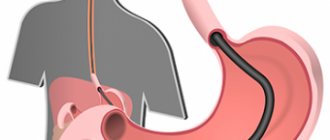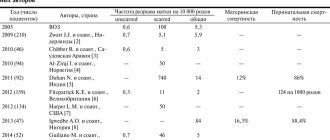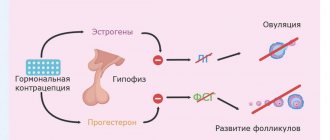Cerebral ischemia, to put it simply, is an insufficient supply of blood to the child’s brain. This can lead to disability and even cause death. In most cases, hypoxic-ischemic encephalopathy is diagnosed, and not strictly ischemia in recently born babies. Hypoxic-ischemic encephalopathy means that the cells do not receive the necessary doses of oxygen, which is why pathological processes begin in the brain.
- Causes
- Pathogenesis (essence of pathology)
- Risk factors for pathology
- Degrees
- Signs of severe ischemia
- Cerebral ischemia in prematurity and in full-term infants
- Hypoxia results
- Diagnostics
- Treatment
- Prevention of ischemia
Causes
In newborns, the pathology in question can be provoked by the following factors:
- During contractions and pushing, the umbilical cord is pinched, which affects the blood supply to the brain and other organs
- long labor
- placental abruption
- acute placental insufficiency
- asphyxia (suffocation) during childbirth
- intrauterine hypoxia
- prematurity, which causes respiratory failure in the baby
- patent ductus arteriosus
- disruption of blood flow to the heart
- congenital heart defects
- sepsis, which causes the child’s blood pressure to decrease
- heavy bleeding caused by various reasons
Diagnosis of chronic cerebral ischemia
If you suspect chronic cerebral ischemia or any other cerebrovascular accident, you should consult a neurologist. At the Aximed neurology clinic, during a consultation, an experienced specialist will examine the patient’s complaints, clarify his personal and family history, and conduct a physical examination and neurological tests.
Mandatory examinations that the doctor will prescribe are as follows:
- laboratory blood tests
- ophthalmologist consultation
- MRI of the brain
- Dopplerography of head and neck vessels
- electroencephalogram
- therapist consultation
- X-ray of the cervical spine
- and other studies as indicated
Pathogenesis (essence of pathology)
For the health and life of a child, oxygen is needed, which is carried through the blood to all organs and tissues of the body. If there is not enough of it, then the blood in the organs is redistributed; this is a natural regulation of the body. Blood with important oxygen begins to flow mainly to the heart and brain. At the same time, other organs experience a lack of both. If the cause of oxygen starvation is not eliminated, then asphyxia gradually develops, and the nerve cells will not be able to exist for so long. They die off. This is the essence of the process of cerebral ischemia in newborns.
It is logical that the greater the risk for a child, the larger areas of the brain that are damaged. In some children with such problems, blood spills into the brain, which can have very sad consequences.
Treatment of chronic cerebral ischemia
Depending on the stage of the disease, its causes and the patient’s condition, different treatment tactics can be chosen.
First of all, treatment measures will be aimed at eliminating the causes of ischemia. For these purposes, medications are used (lowering blood pressure, reducing cholesterol levels and blood viscosity, reducing elevated blood glucose levels, neurometabolics, venotonics, improving cognitive functions, and others. Physiotherapy and therapeutic massages are successfully used in the complex of therapeutic measures. According to indications, surgical intervention is performed - in the presence of tumors, vascular aneurysms, severe heart defects.
When treating grade 2 and 3 cerebral ischemia, the patient needs rehabilitation measures that will slow down the progression of the disease, help alleviate symptoms, social adaptation and improve the quality of life. An individual recovery program will be developed for the patient, taking into account the patient’s current condition, the degree of brain damage and the neurologist’s prognosis.
Neurologists at the Aximed clinic remind you that if treatment for chronic cerebral ischemia is started in a timely manner, the prognosis is positive, however, the disease is prone to progression and complications, therefore, if you have this diagnosis, you must regularly undergo a medical examination and follow the doctor’s instructions regarding medications, diet and a healthy lifestyle .
Risk factors for pathology
On the mother's side, factors may be:
- epilepsy in a pregnant woman
- neurological pathologies in the family, in close relatives
- endocrine disorders, including thyroid dysfunction
- infertility therapy
- pathology of the placenta
- preeclampsia and eclampsia
- emergency caesarean section
- fever at the time of birth (body temperature more than 38˚ C)
- labor lasting up to 2 hours (called rapid labor in medicine)
- lack of professional medical assistance
- low birth weight
- gestation period up to 37 weeks
- The pregnancy period is more than 42 weeks.
- heavy bleeding during pregnancy and at the time of birth
But the presence of any of these reasons does not mean that the child will have hypoxia at the time of birth or after birth. They only affect how healthy the baby will be and how safe the birth will be. Many factors-causes are connected. For example, bleeding, abnormal placental function and condition, and low infant weight are associated. When they are combined, an emergency cesarean section is often prescribed or premature birth occurs. And in some cases, cerebral ischemia occurs in the newborn.
About 70 out of 100 babies with encephalopathy had developmental disorders and risk factors already when they arrived in the expectant mother’s belly. A quarter of the children also had less than healthy births. And only a small percentage of babies developed ischemia after they were born.
Causes of development of chronic cerebral ischemia
The causes of the development of chronic cerebral ischemia are closely related to atherosclerotic stenosis, thrombosis, and embolism. A certain role is played by post-traumatic dissection of the vertebral arteries, extravasal (extravascular) compression due to pathology of the spine or neck muscles, deformation of the arteries with constant or periodic disturbances in their patency, and hemorheological changes in the blood. It must be borne in mind that symptoms similar to those that occur with chronic ischemia can be caused not only by vascular, but also by other factors - chronic infection, neuroses, allergic conditions, malignant tumors and other reasons with which a differential diagnosis should be made .
Signs of impaired cerebral blood flow are observed in the following diseases:
- hypertension,
- atherosclerosis,
- hypotension,
- vasculitis (inflammation of blood vessels) of allergic and infectious etiology,
- thromboangiitis obliterans,
- skull injuries,
- abnormalities of the cerebral vascular bed and aneurysms,
- disturbances in cardiac activity,
- blood diseases,
- endocrine pathology,
- kidney diseases and other diseases.
The development of chronic cerebral ischemia is promoted by a number of reasons, which are commonly called risk factors. Risk factors are divided into correctable and non-correctable. Uncorrectable factors include old age, gender, and hereditary predisposition. It is known, for example, that a stroke or encephalopathy in parents increases the likelihood of vascular diseases in children. These factors cannot be influenced, but they help to identify in advance those at increased risk of developing vascular pathology and help prevent the development of the disease. The main correctable factors in the development of chronic ischemia are atherosclerosis and hypertension. Diabetes mellitus, smoking, alcohol, obesity, insufficient physical activity, poor nutrition are the reasons that lead to the progression of atherosclerosis and the deterioration of the patient’s condition. In these cases, the blood coagulation and anticoagulation system is disrupted, and the development of atherosclerotic plaques is accelerated. Due to this, the lumen of the artery is reduced or completely blocked. At the same time, the crisis course of hypertension is especially dangerous: it leads to an increase in the load on the blood vessels of the brain.
Degrees
- light
With mild ischemia, muscle tone increases, but not too much. Deep tendon reflexes in such children are enhanced. They suckle poorly, cry constantly, or, conversely, sleep constantly. During the first 3 days of life, manifestations of pathology are eliminated. Children who have not spent 9 months in their mother’s belly may have decreased rather than increased reflexes and muscle tone.
- average
- frequent apneas
- decreased grasping and sucking reflex
- sluggish Moro reflex
- decreased tendon reflexes
- weak muscle tone
Symptoms of moderate ischemia in newborns appear in the first 24 hours after birth. Doctors talk about a favorable prognosis if the symptoms of ischemia disappear within 14 days.
- heavy
- uncoordinated eye movements
- strabismus, nystagmus
- lack of reflexes that a newborn should normally have
- irregular breathing, such children have to be connected to a ventilator
- stupor or coma
- convulsions
- surges in blood pressure (BP)
- heart rhythm disturbances
How does the disease manifest itself?
This pathology has varying degrees of manifestation. Stage 2 cerebral ischemia in newborns has serious symptoms, and immediate treatment is required. Here's what should alert doctors and mommy:
- Decreased muscle tone.
- Large pauses in breathing.
- Tendon reflexes are poor.
- Sluggish Moro reflexes.
The following syndromes are also noted:
- Syndrome of increased excitability, which manifests itself in crying for no reason, restless and superficial sleep, twitching.
- Hydrocephalic syndrome can be recognized by an increase in the size of the head and a large fontanel.
- Convulsive syndrome is present.
- If there is grade 2 cerebral ischemia in newborns, depression syndrome reduces sucking and swallowing reflexes, muscle tone is weakened, and strabismus may occur.
- The most serious syndrome is comatose. If it is present, the baby’s condition is serious, there are no reflexes, no reaction to external stimuli, low blood pressure, and breathing problems appear.
Signs of severe ischemia
- Disorders of internal organs, including the heart
- Coma, absence of tendon reflexes and muscle tone
- 0-3 points on the Apgar scale after the first 5 minutes of life
The Apgar scale evaluates the following signs from 0 to 2 points:
- color of the skin
- state of reflexes
- muscle tone
- breathing attempts
- heart rate
The condition of the newborn is determined one minute after birth and after five minutes. After 1 minute of life, the doctor decides whether the child needs resuscitation. At the fifth minute, you can determine if there is hypoxia that has affected the brain.
Which vessel is the main one?
The study of blood circulation in the vessels of the head made it possible to identify ischemic disease of the brain by analogy with the heart. The level of damage depends on the underlying disease.
- Myocardial weakness - with coronary heart disease, general circulatory failure. Some authors identify coronary-cerebral syndrome, which indicates an underlying pathology in the heart.
- Narrowing of the aorta and its branches - coarctation of the aortic arch, atherosclerosis, vascular deformation.
- Impaired patency in the internal carotid and vertebral arteries - narrowing of the diameter, structural anomalies, bends, compression due to osteochondrosis.
- Inadequacy of intracerebral circulation - undeveloped anastomoses, congenital changes.
The most massive damage to brain cells occurs with general hypoxia (oxygen deficiency) due to heart weakness. Local changes are caused by damage to specific nuclei responsible for certain body functions.
Diagram of blood supply pathways to the brain
Cerebral ischemia in prematurity and in full-term infants
At term and at prematurity, the nature of brain damage is different. If a baby is not carried to term for 9 months, he or she is at risk of periventricular leukomalacia (PVL). This means that the white matter of the brain, located near the ventricles, dies and cysts form there.
PVL causes dementia and cerebral palsy in those born before the 31st week of gestation.
And for those who spent the entire period in the mother’s belly, damage mainly occurs to the cerebral cortex, that is, to the gray matter. The consequences for the child will depend on where the necrotic zone is located and how large it is. In acute and severe asphyxia (suffocation), damage to the brain stem is likely. Therefore, the child will have problems with heartbeat and breathing, which in some cases causes death, that is, death.
Clinical manifestations of cerebral crises
Manifestations depend on the level of vascular damage.
Symptom complexes of crises occur in different ways:
- repeated headaches in the same area;
- dizziness with impaired balance, a feeling of “rotation of objects”, “shaking of the ground”;
- short-term fainting;
- darkening of the eyes with temporary loss of the visual field;
- sudden loss of consciousness, loss of orientation with rapid recovery;
- attacks of numbness and coldness of the extremities;
- speech disorders;
- “rushes” of blood to the head and redness with pulsation in the temples;
- insomnia and “influx of thoughts” at night;
- short-term pain in the heart, arrhythmias.
Hypoxia results
A lack of oxygen to the brain can have the following results:
- Severe cerebral ischemia
This condition is fatal in a quarter to half of cases. The babies do not survive even a few days. Another scenario is pneumonia or another infection that kills the child a little later. Most of those who do not die are diagnosed with autism, cerebral palsy or dementia. And only 10% of survivors experience no consequences.
- Moderate ischemia
According to statistics, severe long-term consequences occur in 30 to 50% of children.
- Mild ischemia
The outcome in most cases is favorable, no disability is noted.
Komarovsky's opinion on the disease
If there is grade 2 cerebral ischemia in newborns, Komarovsky believes that drug therapy gives a result, but not what everyone expects. It is very important in the acute period, when the impact of the damaging factor on the brain is observed, but, as a rule, pathology is detected much later, when the so-called recovery period for the brain begins. At this time, massage and physiotherapeutic procedures will be more effective, which will help the brain recovery process. Dr. Komarovsky believes that all neurological manifestations in newborns are associated with brain immaturity, which will gradually disappear if there are no serious chronic pathologies.
Diagnostics
Doctors usually find ischemia in a baby in the first few days after birth. If the degree of oxygen starvation is severe, then the child may be in a normal state for 3-4 hours or even several days, and then suddenly a very bad state occurs. Therefore, it is important to thoroughly examine the baby.
Examination of the baby . Doctors assess the patient's situation using the Apgar scale, which was discussed above. To do this, reflexes are checked, body weight and height are measured.
Analyzes:
- general blood analysis
- electrolytes
- coagulability
- gases
Magnetic resonance imaging is performed if cerebral ischemia is severe or moderate. MRI is almost never used for mild cerebral ischemia in a newborn. Using ultrasound, it is impossible to accurately determine encephalopathic processes, and it is worth considering that the result may be false positive. Ultrasound can be used to make a primary diagnosis, but other studies are required.
The current method is electroencephalography, abbreviated as EEG. Mandatory for children with severe degrees of the pathology in question. EEG makes it possible to detect hidden seizures. The method also shows how damaged the brain is and how active it can be. An EEG is also done to choose adequate treatment.
Main goals of ischemia therapy
If the diagnosis is confirmed after all the studies, then measures begin to maintain normal temperature, humidity, and protection from external irritants.
Therapy in newborns should be as less aggressive as possible. It pursues the following goals:
- Provide adequate ventilation.
- Support hemodynamics.
- Constantly monitor the biochemical parameters of the tests.
- Prevent seizures.
Treatment
To date, specific therapy that “revives” dead brain cells has not been developed. There are medical methods that stop the process of hypoxia and death so that the child does not die.
Treatment of acute ischemic period
As already noted, severe and moderate cerebral ischemia makes itself felt immediately, the symptoms are specific. If there is no spontaneous breathing in the first 2 minutes of life (as well as in the absence of breathing with an oxygen mask), resuscitation must be performed. do intubation and mechanical ventilation. If small areas of the brain are damaged, then 2-3 minutes after the start of resuscitation the baby is already breathing on his own. Then the child is given to the mother. Such a small patient is being observed.
If resuscitation takes longer, the baby is taken to the intensive care unit. There you need to constantly monitor the readings of the body’s condition, including the amount of glucose and hemoglobin in the blood, the level of gases, the processes of blood circulation and the beating of the newborn’s heart. There is special equipment for this.
Anticonvulsant therapy consists of prescribing special drugs, for example, phenytoin. The dose is selected by the doctor individually. This helps stop the seizures and prevents further brain damage. Since ischemia has a negative effect not only on the brain, but also on the heart, special therapy is needed for this organ. To prevent the little patient’s heart from stopping, he is injected with dobutamine and dopamine.
Today, research data is relevant that a temperature that is 3-4 degrees lower than normal can save parts of the brain from dying, which prevents disability and death. This method is called hypothermic therapy. It has been practiced not so long ago, only since 2010. It is necessary that the process be supervised by experienced doctors. The patient is warmed up gradually.
Treatment of consequences
As mentioned above, there are always consequences for a child with severe and even moderate cerebral ischemia. It could just be attention deficit disorder. But in other cases, mental retardation and cerebral palsy are noted. If there are convulsions, special drugs are used to stop them. Prescribed by a doctor in an individual dosage; self-medication is strictly prohibited.
If the baby has severe cerebral palsy with spasticity of the limbs, then muscle relaxants are taken to alleviate the situation. Whatever the consequences, treatment will not be limited to medications. Daily rehabilitation is important. Children with cerebral palsy are given special massage courses. This should be done by a specialist. At home, you can do only part of the exercises that experts will show parents. Older children who are diagnosed with cerebral palsy due to cerebral ischemia need exercise therapy.
Correction of incorrect postures is carried out using special devices: strollers, bolsters, splints, special chairs. If there is spasticity, the arms and legs of a sick baby may become unphysiological. It's better to avoid this.
In our country there are few specialists who can adequately treat the consequences of cerebral ischemia in newborns. There is overdiagnosis. Children under 6 months of age may have Graefe's sign, increased muscle tone and shuddering. And doctors may think that these are manifestations of encephalopathy. Accordingly, they will prescribe treatment that is actually unnecessary.
Newborns should not be examined when they are drowsy or frightened in some way. Then it is also possible to diagnose neurological pathologies that do not exist. Unnecessary medications that may be prescribed in error include:
- vascular
- nootropics
- homeopathy
Prevention of ischemia
It is necessary to talk about pregnancy in advance. Preparations begin half a year, or at most 3 months before conception. And not only the expectant mother, but also the father of the child must prepare. During gestation, a woman should undergo all examinations on time, especially in the first trimester. Tests are taken and ultrasound diagnostics are performed.
Before and during pregnancy, a woman is examined for infections. As is known, after conception, latent infections can worsen and manifest themselves. Mom needs to give up smoking, alcohol, drugs and other habits that are harmful to her and the baby. Smoking has a particularly negative effect on the process of oxygen supply to the fetus. If the doctor discovers pregnancy complications, it is important for the woman to go to the hospital on time.
What happens to neurons?
As a result of insufficient supply of oxygen and nutrients in brain cells, energy production is disrupted, followed by a decrease in the intensity of all types of metabolic processes and ionic balance.
If the oxygen saturation of the blood drops to 60% or lower, the vessels dilate as much as possible, but automatic regulation no longer works. The conduction of impulses through cellular connections is disrupted to the point of paresis, then completely stops.
The myelin sheath of nerve fibers is replaced by connective tissue.
These are “healthy” nerve cells under an electron microscope; through connections they transmit impulses along the fiber








